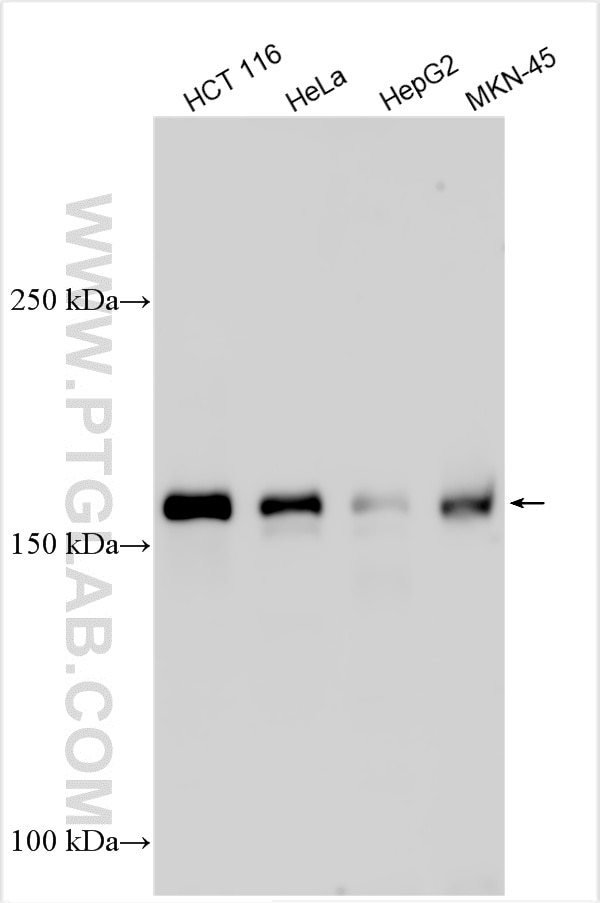Anticorps Polyclonal de lapin anti-PTPRF
PTPRF Polyclonal Antibody for WB, ELISA
Hôte / Isotype
Lapin / IgG
Réactivité testée
Humain
Applications
WB, ELISA
Conjugaison
Non conjugué
N° de cat : 14138-1-AP
Synonymes
Galerie de données de validation
Applications testées
| Résultats positifs en WB | cellules HCT 116, cellules HeLa, cellules HepG2, cellules MKN-45 |
Dilution recommandée
| Application | Dilution |
|---|---|
| Western Blot (WB) | WB : 1:500-1:1000 |
| It is recommended that this reagent should be titrated in each testing system to obtain optimal results. | |
| Sample-dependent, check data in validation data gallery | |
Informations sur le produit
14138-1-AP cible PTPRF dans les applications de WB, ELISA et montre une réactivité avec des échantillons Humain
| Réactivité | Humain |
| Hôte / Isotype | Lapin / IgG |
| Clonalité | Polyclonal |
| Type | Anticorps |
| Immunogène | PTPRF Protéine recombinante Ag5374 |
| Nom complet | protein tyrosine phosphatase, receptor type, F |
| Masse moléculaire calculée | 1898 aa, 212 kDa |
| Poids moléculaire observé | 175 kDa-200kDa |
| Numéro d’acquisition GenBank | BC048768 |
| Symbole du gène | PTPRF |
| Identification du gène (NCBI) | 5792 |
| Conjugaison | Non conjugué |
| Forme | Liquide |
| Méthode de purification | Purification par affinité contre l'antigène |
| Tampon de stockage | PBS with 0.02% sodium azide and 50% glycerol |
| Conditions de stockage | Stocker à -20°C. Stable pendant un an après l'expédition. L'aliquotage n'est pas nécessaire pour le stockage à -20oC Les 20ul contiennent 0,1% de BSA. |
Informations générales
PTPRF (Protein Tyrosine Phosphatase Receptor Type F) is a receptor protein tyrosine phosphatase, also known as LAR. PTPRF is a transmembrane protein with extracellular domain, transmembrane domain and two intracellular catalytic domains in series. It is located in the cell membrane and participates in the interaction between cells or cell matrix. It is widely expressed in many tissues, including fat, skin, heart, lung, liver, kidney, pancreas, small intestine, colon, brain, skeletal muscle, spleen, peripheral white blood cells and so on. The protein plays an important role in regulating a variety of cell processes, including cell growth, differentiation, mitotic cycle and carcinogenic transformation. In the insulin-responsive tissues of obese and insulin-resistant individuals, the expression level of PTPRF is increased, which may contribute to the pathogenesis of insulin resistance. PTPRF showed expression changes in many cancers, such as breast cancer, thyroid cancer, non-small cell lung cancer and so on. In gastric adenocarcinoma, PTPRF, as a new tumor suppressor, plays a role by inactivating ERK1/2 signaling pathway (PMID: 32973331). The total length of the protein is 175-200kd, and after cutting, it forms 125-150 and 80-85kd,70 and 72kDa fragments (PMID: 1547787, PMID: 17259169).
Protocole
| Product Specific Protocols | |
|---|---|
| WB protocol for PTPRF antibody 14138-1-AP | Download protocol |
| Standard Protocols | |
|---|---|
| Click here to view our Standard Protocols |


